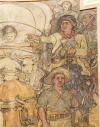
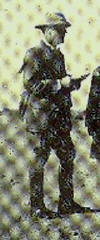
Charles Darwin
- during the five years in which he made his famous scientific journey
around the world, he took every opportunity to explore the
continents of South America, Australia and Africa on horseback. Darwin
wrote of "The pleasure of living in the open air with the sky for a
roof and the ground for a table."
In contemplating the brilliant intellectual achievements of the past, Charles Darwin's name is often mentioned. Whether you agree with his famous "Theory of Evolution" or not, Darwin's impact on the course of modern events cannot be denied. His was a life whose resonance is still being felt around the globe. It goes against the grain of common perception to think of this scientific titan galloping over the pampas of Argentina, exploring volcanic islands on horseback, and lying down to rest on the bosom of the earth with his horse nearby. Yet Darwin's diaries tell the story of not just a naturalist exploring the world searching for answers, they also reveal the inner man, the Long Rider who revelled in the freedom of riding on three continents, South America, Australia, and Africa. For as these varied diary entries explain, Charles Darwin the Scientist, soon discovered that when you are a Long Rider you often find astonishing acts of kindness awaiting you out on the long grey road to adventure.
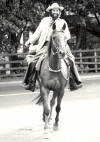
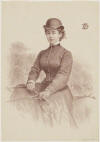

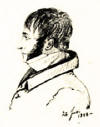
Edward Dodwell is the ancestor of the modern Long Rider Christina Dodwell. Before he became an equestrian explorer, Dodwell was an officer who was captured by the French during the Napoleonic Wars. He was granted parole, provided that he did not return to Britain to fight again. This prompted Dodwell to set off in 1801 to ride through Greece instead. He spent the next five years searching for architectural evidence of Greek’s classic period. In addition to writing about the wonders of that lost world, in his book Dodwell also made keen equestrian observations. For example, he recalled how his pack horse fell into a stream, thereby damaging the beautiful paintings he had painstakingly made of the ancient buildings. Ever the student of architecture, Dodwell also recorded how the Greek Orthodox churches were intentionally built with doors so narrow as to allow only one person to pass through. This was designed to deter Turks from turning the churches into stables.
But the Irish Long Rider’s most significant equestrian discovery was that despite the passage of centuries, the distances he travelled on horseback matched those made by Greek scholars who had ridden the same roads centuries before.
“Distances in Greece are not regulated by measure, but computed by time. The Tatars, who travel on small and fleet horses, without any encumbrance, except their pipe and tobacco bag, pass over rocks and mountains, through forests, swamps, and trackless wilds, with a truly astonishing velocity. They accordingly use a totally different method of computation from that which is commonly adopted in Greece by those who travel with luggage horses, which are calculated to go throughout the day's journey, at the average pace of three miles an hour ; but from this rate, some deductions must be made in mountainous roads. This rough kind of calculation is more accurate than might be imagined. The Author, during his journey, measured all the distances by this method, and comparing the result with the Greek historian Strabo (64 BC) and the Greek traveller Pausanias (200 AD ), he had the satisfaction to find, that the difference was frequently very immaterial.”
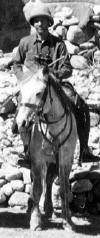
Brook Dolan -
rode from India to China, via Tibet,
thereby accomplishing a secret
diplomatic mission entrusted to him by the American president,
Franklin Delano Roosevelt. Like all political events, there were public and
private reasons behind this decision. By the spring of 1942 the war against
Japan and the Nazis looked grim. The Japanese had conquered the eastern
portion of the previously impregnable British Empire, starting with their
capture of the fortress of Singapore and concluding with their occupation of
Burma. With India threatened, and their allies in China surrounded by
hostile Japanese forces, Roosevelt and Churchill hatched the idea of using
the mountainous kingdom of Tibet as a transit station for supplies to be
moved overland from India to China.
Mind you, there were a few small problems with this plan. In addition to
climbing over the natural obstacle of the mighty Himalayan mountains, there
was the danger of dying of altitude sickness brought on by trying to make
your way across the highest country in the world, not to mention the
legendary antagonism expressed by most Tibetans towards unwelcome outsiders.
But what the Tibetans didn’t know was that FDR was a fan of their country.
Having read the romantic novel “Shangri-la,” the president became intrigued
with the mysterious mountain kingdom. He even dubbed the presidential
retreat Shangri-la, though more pragmatic presidents now call it Camp
David. So when the idea was presented to him for an official American
diplomatic mission to ride from India, over the mountains to Lhasa, and then
make their way overland through the backdoor of China, Roosevelt couldn’t
say “no.”
Enter the most unlikely Long Rider in Tibet’s long history, the dashing
Count Ilya Tolstoy.
Roosevelt’s appointed Long Rider ambassador was a grandson of the famous
Russian author, Leo Tolstoy. The elder Tolstoy was so passionate about
horses that his friend and fellow author, Ivan Turgenev, accused him of
having been a horse in his previous life! The famous author of War and
Peace, who had hosted the Swedish equestrian explorer Vladimir Langlet,
rode right up to his death. Coming from such a strong equestrian background,
it was no wonder the author’s grandson, who had studied and settled in
America before the war, was chosen by Roosevelt to head this delicate
equestrian diplomatic mission.
Accompanying Tolstoy was Captain Brooke Dolan, a brilliant Princeton
University naturalist turned US army spy.
Their mission was simple. Go to India. Find horses. Ride over the Himalayas
to Lhasa without getting killed. Introduce themselves to the Dalai Lama.
Entice him to become a diplomatic ally. Then ride on to China before
reporting back to Washington DC.
To assist them FDR provided the Long
Rider ambassadors with a number of lovely gifts deemed appropriate for the
young ruler of Tibet, including a silver framed photograph of the president
and a precious gold chronograph watch.
After riding over 14,000 foot high
passes, floating their horses across the Brahmaputra river on an ancient
flat-bottomed barge, and convincing a number of suspicious Tibetan officials
that they were ambassadors, Tolstoy and Dolan reached Lhasa, where they met
the ten-year-old Dalai Lama.
With their mission essentially concluded, and no formal permission for a
road having been granted, the Long Riders received permission to depart in
February, 1943. Their equestrian journey didn’t end however until they rode
into a Chinese frontier outpost on June 21st.
After their return to the United States, Dolan was sent back to China.
Sadly, the young naturalist, turned army officer, was killed soon after
combat had been officially concluded with Japan. So it was left to Tolstoy
to record the tale of their remarkable equestrian journey in his “Story from
the Road,” entitled
Across Tibet from India to China.

Fanny
Duberly led one of the most dashing and dangerous lives of the
mid-nineteenth century. In 1854, while still in her early twenties, Fanny
accompanied her husband Henry and his regiment to the front lines of the
Crimean War to fight the Russians. Considered the first female "embedded
reporter," Fanny's eye-witness account of the horrors of the Crimean War
includes the infamous Charge of the Light Brigade. After having survived
bullets, cholera and shipwreck, Fanny and her husband next saw action in
India. In 1857 Fanny rode more than two thousand miles through the deserts
of India alongside Captain Duberly and his troops during the suppression of
the Sepoy Revolt.
This remarkable Long Rider was the author of two fascinating books entitled Crimean Journal and Indian Journal.
The photograph on the left shows Fanny on her horse, Bob, with Henry standing in front of her.

John Duncan was a Scotsman who set off on horseback in 1844 in search of West Africa’s mysterious Kong mountains. The former cavalryman turned explorer had originally ridden in Queen Victoria’s elite Life Guards. Despite the equatorial heat, Duncan dressed in his ceremonial uniform, with glistening cuirass, helmet, gauntlets and high boots. During this remarkable journey Duncan was befriended by the infamous African despot, King Gezo, who urged the Scotsman to drink to Queen Victoria’s health in a goblet carved from a human skull. Additionally, Duncan came in contact with several flourishing African cavalry cultures, the existence of which has been almost completely overlooked by western scholars. Although Duncan never found the Kong mountains, his original travel account, Travels in Western Africa, as well as a new biography regarding this brave Long Rider, The King’s Stranger,” are both available via the Long Rider’s Guild Press.

Long Riders often become
associated with the countries where they travelled. The majority of such
cases involve countries with famous equestrian cultures such as Mongolia or
Argentina. Yet Edith Durham’s equestrian travels have linked her to
the unlikely nation of Albania. Like her predecessor, Isabella Bird, Durham
(1863
– 1944) began her life in England surrounded by domestic obligations. A
loyal daughter, she remained unmarried. After her father died Durham spent
years taking care of her ill mother. It wasn’t until she was 37 that Edith
found herself free to travel. Having become exhausted while tending to her
dying mother, Durham followed the doctor’s advice to take a holiday. She
sailed to the coast of Dalmatia and then ventured inland to Montenegro.
This journey exposed her to the tempestuous life, politics and culture of the southern Balkans. Edith soon developed a passion for Albania and championed the downtrodden little nation which was still part of the Ottoman Empire. She spent the next twenty years loudly advocating Albania’s right to independence to the foreign press.
But she was no desk-bound dilettante. Durham explored Albania extensively on horseback. During her many journeys she carried on anthropological research, documented the urgent need for relief work and collected endangered Albanian folk art.
One reason her many equestrian journeys were successful was thanks to Edith’s understanding of Albanian culture. She benefited from invoking the nation’s ancient tradition of extending protection and hospitality to “Sworn Virgins.” These were women who donned men’s clothes, took a vow of chastity and lived as men in the mountainous patriarchal society of northern Albania.
In addition to being made a Fellow of the Royal Anthropological Institute, Durham wrote seven popular books about her life and travels in the Balkans, the best known being High Albania (1909). Edith’s unwavering support for Albania earned her the enmity of those who favoured incorporating Albania into the cause of Yugoslav unity.
The Albanians however revered the outspoken Long Rider and referred to her as the "Queen of the Highlanders." Upon her death, Albania’s King Zog wrote, "She gave us her heart and she won the ear of our mountaineers." More recently, in 2004 Durham was described as “"one of the most distinguished personalities of the Albanian world during the last century,” by Albanian President Alfred Moisiu.